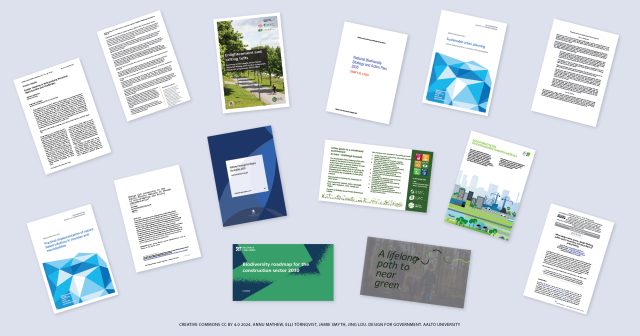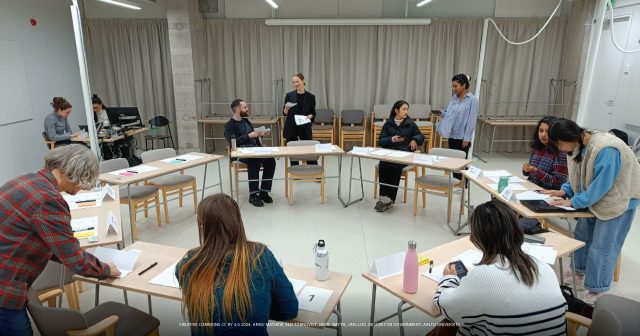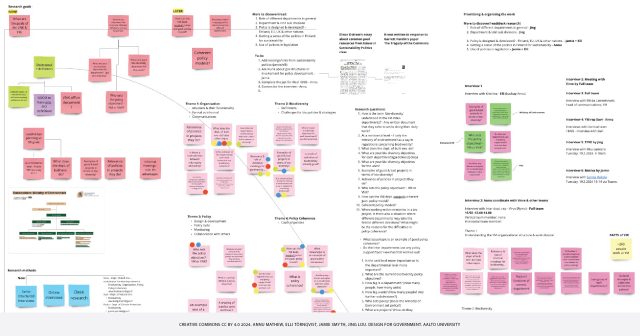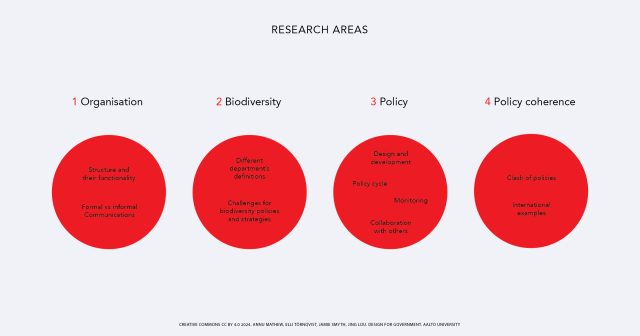This blog post reports on work-in-progress within the DfG course! The post is written by group 1B dealing with the Ministry of Environment’s brief on ‘Biodiversity policy coherence’. The group includes Annu Mathew from the Collaborative and Industrial Design program, Elli Törnqvist, Jamie Smyth and Jing Lou from the Creative Sustainability program.
Written by Jamie Smyth
Introduction: what is biodiversity policy coherence?
The Merriam-Webster Dictionary defines biodiversity as the “biological diversity in an environment as indicated by numbers of different species of plants and animals”. Human activity, such as farming and urban development, alongside climate change, is causing unprecedented biodiversity loss. This is a problem as biodiversity affects many issues such as the amount of carbon that can be sequestered in the natural environment; the habitats of endangered species; the health of pollinators (which are crucial for crop production); the microbial diversity that builds human and animal immune systems; as well as utilitarian human needs such as food, shelter and medicine. The Finnish government is committed to halting biodiversity loss. A national action plan is being prepared with the aim of halting the loss of biodiversity by 2030 and turning the trend towards recovery by 2035.
Aalto University and the DfG course have teamed up with the Ministry of the Environment and the Prime Minister’s Office to make sure everyone in the government is on the same page when it comes to biodiversity policy. Our group, 1B, is focused on improving how the Ministry of the Environment coordinates its biodiversity policies across different departments. But before we could take on this task, our group needed to tackle a much more basic challenge: do we even understand what biodiversity means in a Finnish context? And what actually is policy? And …policy coherence?

Some of the background material read by group 1B so far.
Step one: familiarising ourselves with the issues
To begin answering these questions, our group kicked off our research by reading through some background material picked by the DfG tutors to give us context on our topics. These included political strategy plans, reports from think tanks, and academic papers. One of documents I was assigned to read was a draft of The National Biodiversity Strategy and Action Plan for 2035 which outlines how Finland will tackle the biodiversity crisis. At several points, it mentions the importance of policy coherence for halting biodiversity loss. I could see now why we had been assigned this brief. The report included some unexpected (and disheartening) examples of past failures in attempting to halt biodiversity loss. For example, it mentions that over two-thirds of the objectives implemented from Finland’s biodiversity strategy 2012–2020 had little positive impact.
When we met as a group to discuss our assigned readings, we came back again and again to how interlinked biodiversity is with other issues. The National Biodiversity Strategy and Action Plan for 2035 covers everything from forestry to marine life to the construction sector. This interlinked nature is relevant to our brief as it means all departments of the Ministry of the Environment, from the Department of Built Environment to the Ministerial Governance and International Affairs Department, are equally important when considering biodiversity. Any attempt to improve biodiversity policy coherence will require a systemic perspective that understands government as a single unit despite its many subdivisions.
Now that we were familiar with the issues we could see the scale of challenge ahead – how to improve the coordination of the roughly 300 people at the Ministry of the Environment? To begin answering this we realised we needed to ask a whole lot more questions. How does the Ministry of the Environment function day-to-day? How often are they discussing biodiversity? How are they creating policy? Who are the people who work there?
“Halting biodiversity loss also requires policy coherence at all levels of government and between different sectors of government. In other words, the objectives of policy instruments must be as consistent as possible”
Ministry of the Environment (2024). National Biodiversity Strategy and Action Plan 2035 (Draft). Helsinki: Ministry of the Environment

Group 1A, 1B and 1C planning before the kickoff of the roundtable. Photo by Meeri Aaria.
Step two: hosting our first roundtable with our partners
On the 6th of March, all three student groups working on biodiversity policy coherence hosted a roundtable at Aalto with our external partners. From the Ministry of Environment, we were joined by three senior specialists from the Department of Natural Environment, the Department of the Built Environment, and the Ministerial Governance and International Affairs Department. From the Prime Minister’s Office, we were joined by a Leading Expert.
The three student groups collaborated to prepare a set of questions covering four themes we considered most important to understand at this stage: biodiversity, collaboration, policy implementation, and future and change. We spoke for two hours fuelled by coffee, biscuits, and cake. As one of the two students facilitating the conversation, I found the roundtable very enjoyable but quite tiring. It was demanding to juggle listening to our partner’s answers while formulating follow-up questions, all while following a tightly outlined schedule. After the roundtable, our group’s key takeaway was how differently government and policy functions compared to our initial conception. There are many more informal meetings and communication channels than we anticipated, policy implementation was not the linear process we expected, and we were surprised to discover that there is no shared definition or understanding of biodiversity across the government (or even within the Ministry of the Environment!). The insights from the roundtable set us up for our next step: defining our research agenda.

The process of drafting group 1B’s research agenda.
Step three: defining a research agenda
Drawing from all our research so far, our group chose four areas to focus on in our research agenda: organisation, biodiversity, policy and policy coherence. To dive deeper into these areas, we organised meetings with a Special Expert from the Prime Minister’s Office, the Head of Communications at the Ministry of the Environment, and a Senior Specialist from the Department of the Built Environment at the Ministry of the Environment. Interestingly, each stakeholder mentioned the same obstacle. We had anticipated that the main obstacle would be a lack of awareness of the importance of policy coherence. Rather, again and again in our interviews, it was mentioned that there is a lack of resources to focus on these topics. For example, one interviewee mentioned that there was a lack of time and money for evaluating the effectiveness of policy. Another interviewee highlighted how “there aren’t resources” for these topics and how it was “hard to find people [from the Ministry of the Environment] who have a spare hour to be interviewed by students” for this project. I came away from these interviews feeling that the lack of resources is one of the primary obstacles to achieving biodiversity coherence and whatever we do going forward will need to take this into consideration.

Group 1B’s research areas with sub-categories included.
Concluding thoughts
Our group’s overall perspective on biodiversity policy coherence at this stage in the process is that we are dealing with two complex systems at once: biodiversity and government. I have found myself thinking of the environmental scientist Donella Meadows and her idea of leverage points frequently. I imagine these might be important going forward. Our next step is to continue our research into our four areas via interviews, surveys, and background reading. We have also begun to collect our initial insights which will act as a guide when we reach the research analysis stage and opportunity areas stage later in the project. Keep an eye out for 1B’s next blog where we will share updates on these next steps!
References
Biodiversity
https://www.merriam-webster.com/dictionary/biodiversity
https://www.un.org/en/climatechange/science/climate-issues/biodiversity
https://www.helsinki.fi/en/news/biodiversity-loss/biodiversity-loss-threat-humanity
Biodiversity policy
https://ym.fi/en/national-biodiversity-policy
https://environment.ec.europa.eu/strategy/biodiversity-strategy-2030_en
Donella Meadows and leverage points
https://donellameadows.org/archives/leverage-points-places-to-intervene-in-a-system/
The DfG course runs for 14 weeks each spring – the 2024 course has now started and runs from 26 Feb to 29 May. It’s an advanced studio course in which students work in multidisciplinary teams to address project briefs commissioned by governmental ministries in Finland. The course proceeds through the spring as a series of teaching modules in which various research and design methods are applied to address the project briefs. Blog posts are written by student groups, in which they share news, experiences and insights from within the course activities and their project development. More information here about the DfG 2024 project briefs. Hold the date for the public finale on Wednesday 29 May!

